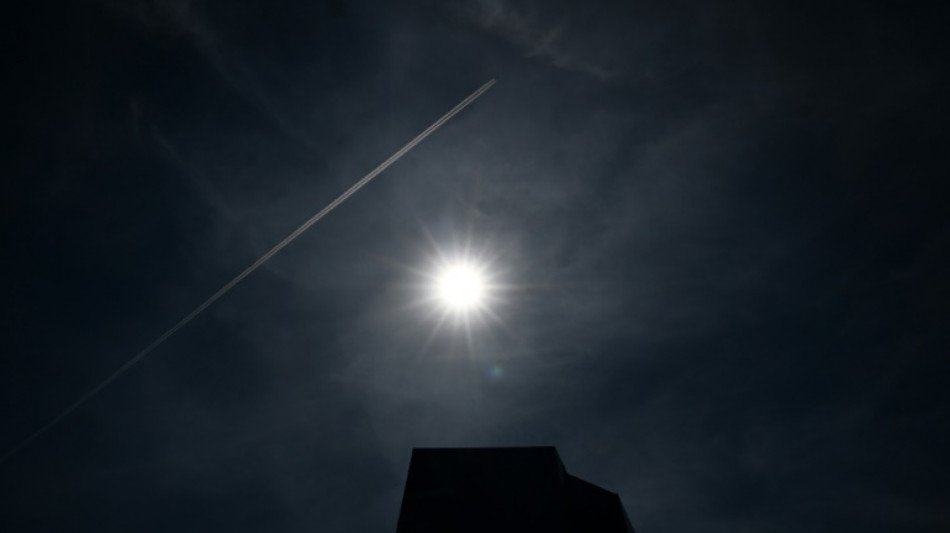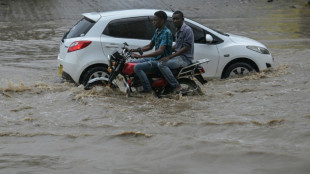
-
 Kenya's economy faces climate change risks: World Bank
Kenya's economy faces climate change risks: World Bank
-
Campaigning starts in Central African Republic quadruple election

-
 'Stop the slaughter': French farmers block roads over cow disease cull
'Stop the slaughter': French farmers block roads over cow disease cull
-
First urban cable car unveiled outside Paris

-
 Why SpaceX IPO plan is generating so much buzz
Why SpaceX IPO plan is generating so much buzz
-
US unseals warrant for tanker seized off Venezuelan coast

-
 World stocks mostly slide, consolidating Fed-fuelled gains
World stocks mostly slide, consolidating Fed-fuelled gains
-
Crypto firm Tether bids for Juventus, is quickly rebuffed

-
 UK's king shares 'good news' that cancer treatment will be reduced in 2026
UK's king shares 'good news' that cancer treatment will be reduced in 2026
-
Can Venezuela survive US targeting its oil tankers?

-
 Salah admired from afar in his Egypt home village as club tensions swirl
Salah admired from afar in his Egypt home village as club tensions swirl
-
World stocks retrench, consolidating Fed-fuelled gains

-
 Iran frees child bride sentenced to death over husband's killing: activists
Iran frees child bride sentenced to death over husband's killing: activists
-
World stocks consolidate Fed-fuelled gains

-
 France updates net-zero plan, with fossil fuel phaseout
France updates net-zero plan, with fossil fuel phaseout
-
Stocks rally in wake of Fed rate cut

-
 EU agrees recycled plastic targets for cars
EU agrees recycled plastic targets for cars
-
British porn star to be deported from Bali after small fine

-
 British porn star fined, faces imminent Bali deportation
British porn star fined, faces imminent Bali deportation
-
Spain opens doors to descendants of Franco-era exiles

-
 Indonesia floods were 'extinction level' for rare orangutans
Indonesia floods were 'extinction level' for rare orangutans
-
Thai teacher finds 'peace amidst chaos' painting bunker murals

-
 Japan bear victim's watch shows last movements
Japan bear victim's watch shows last movements
-
South Korea exam chief quits over complaints of too-hard tests

-
 French indie 'Clair Obscur' dominates Game Awards
French indie 'Clair Obscur' dominates Game Awards
-
South Korea exam chief resigns after tests dubbed too hard

-
 Asian markets track Wall St record after Fed cut
Asian markets track Wall St record after Fed cut
-
Laughing about science more important than ever: Ig Nobel founder

-
 Vaccines do not cause autism: WHO
Vaccines do not cause autism: WHO
-
Crypto mogul Do Kwon sentenced to 15 years for fraud: US media

-
 'In her prime': Rare blooming of palm trees in Rio
'In her prime': Rare blooming of palm trees in Rio
-
Make your own Mickey Mouse clip - Disney embraces AI

-
 OpenAI beefs up GPT models in AI race with Google
OpenAI beefs up GPT models in AI race with Google
-
Dark, wet, choppy: Machado's secret sea escape from Venezuela

-
 Cyclone causes blackout, flight chaos in Brazil's Sao Paulo
Cyclone causes blackout, flight chaos in Brazil's Sao Paulo
-
2024 Eurovision winner Nemo returns trophy over Israel's participation

-
 US bringing seized tanker to port, as Venezuela war threats build
US bringing seized tanker to port, as Venezuela war threats build
-
Make your own AI Mickey Mouse - Disney embraces new tech

-
 Time magazine names 'Architects of AI' as Person of the Year
Time magazine names 'Architects of AI' as Person of the Year
-
Floodworks on Athens 'oasis' a tough sell among locals

-
 OpenAI, Disney to let fans create AI videos in landmark deal
OpenAI, Disney to let fans create AI videos in landmark deal
-
German growth forecasts slashed, Merz under pressure

-
 Thyssenkrupp pauses steel production at two sites citing Asian pressure
Thyssenkrupp pauses steel production at two sites citing Asian pressure
-
ECB proposes simplifying rules for banks

-
 Stocks mixed as US rate cut offset by Fed outlook, Oracle earnings
Stocks mixed as US rate cut offset by Fed outlook, Oracle earnings
-
Desert dunes beckon for Afghanistan's 4x4 fans

-
 Breakout star: teenage B-girl on mission to show China is cool
Breakout star: teenage B-girl on mission to show China is cool
-
Chocolate prices high before Christmas despite cocoa fall

-
 Austria set to vote on headscarf ban in schools
Austria set to vote on headscarf ban in schools
-
Asian traders cheer US rate cut but gains tempered by outlook


Plane contrails: white fluffy contributors to global warming
The white, feathery lines behind airplanes that look like bits of harmless cloud are anything but, warn experts, who say they could have a greater environmental impact than the aviation sector's CO2 emissions.
The condensation trails -- contrails, for short -- are being increasingly studied as scientists work with the industry to find technological solutions to the problem.
Classified as non-CO2 emissions from aircraft, in September they were the subject of a symposium in Montreal organized by the International Civil Aviation Organization, a UN agency.
- What are contrails? -
Contrails are clouds that form at high altitudes in cold, humid areas called ice supersaturated regions (ISSRs).
When jet fuel is burned by engines, water vapor condenses on to soot particles to form ice crystals.
Enough ice crystals, and they begin to form cirrus clouds -- high-altitude, wispy white filaments that, when created this way, trail out behind planes as they cross the sky.
These trails trap some of the heat that rises from the Earth at night, preventing it from radiating back out of the atmosphere -- thus acting as a greenhouse gas, causing warming, explains Donald Wuebbles, a professor at the University of Illinois.
Contrails that stay in the sky for a few minutes are not very worrisome, he says.
"But if they form at night, they'll maybe last a little longer, and at night they can cause a warming effect," he adds.
- What is the impact? -
Non-CO2 emissions could account for up to two-thirds of aviation's impact on global warming, which "gives you an idea of how important they are to consider," Wuebbles said.
And contrails could form up to 57 percent of that impact -- far more than the C02 emissions from burning fuel, according to a 2021 study.
However, such emissions are short-lived compared to carbon dioxide and their impact on global warming could be quickly eroded if solutions were found to avoid them, experts say.
- So what can be done? -
Not all flights create contrails -- it can depend on weather conditions and the aircraft's trajectory.
For example, at Air France, just four percent of flights are responsible for some 80 percent of the airline's contrail impact on global warming, notes Irene Boyer-Souchet, who is leading up the company's efforts to mitigate the damage.
The long-term strategy is to modify the trajectory of a fraction of flights.
Air France pilots made more than 3,000 observations over 18 months with the aim of helping Meteo-France improve its forecasts for at-risk areas so that pilots could eventually avoid them.
"The main risk is that by thinking you're avoiding an area, you could end up flying there because it's slightly off the weather forecast," Boyer-Souchet points out, illustrating the importance of fine-tuning the research.
Pilots from American Airlines conducted 70 test flights above or below at-risk areas, guided by satellite images, weather data, software models and AI prediction tools.
A 54-percent reduction in contrails was observed, along with a two-percent increase in fuel consumption.
Accelerating the deployment of a global contrail avoidance system could reduce aviation's impact on the climate by 40 percent, according to a Cambridge University report published in September.
The more flights in the air, however, the more complicated the implementation of such a system would be, notes Boyer-Souchet, who hopes that it will be a reality by 2030.
S.F.Lacroix--CPN
